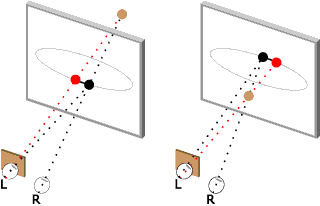Darken one eye with a dark glass and see 3D.
At first, the two unaided eyes of a viewer focus on a black spot which is circling counter-clockwise on an ellipse. By viewing in stereo, the eyes locate the spot in the plane of the screen. As next the viewer shades the left eye - for example with a part of sunglasses. As a result of reducing the amount of incoming light the perception is delayed. Therefore the left eye will send a slightly older image to the brain than the right eye, as shown by the red spot in the left image below.

Now the lines of sight cross behind the plane of the screen. The viewer perceives the stereographic image of the spot further back. After half a revolution on its elliptical path, as the spot moves leftwards, the red and the black line of sight cross in front of the screen (as shown in right image). The spot thus seems to be closer to the viewer. However, if the spot moves clockwise or if the right eye is shaded, the spot seems to come closer on the lower section of its path and recede on the top section.
Experiment with the Pulfrich-Effect by placing a dark sunglass in front of one eye.
Slider 1
Size of the circles
Slider 2
Number of circles
Slider 3
Path of the circles
Slider 4
Animation speed
The eye looking through the filter receives less light than the other and therefore adapts to darkness. This causes a delay in the stimulation process. The most likely physiological explanation for this is that several stimulation thresholds, which the neural signal passes on its way from the eye to the brain, are triggered later the weaker the passing signal is. In order to increase light sensitivity, the retinal receptors become more interconnected, requiring more time. Furthermore it takes the neural signal longer to reach the visual cortex since low light intensity results in slower transmission rates. Instead of placing a filter in front of one eye, the experiment can also be conducted by adapting both eyes individually to darkness, for instance by first looking at a bright source of light with only one eye. The Pulfrich-Phenomena can also occur without the use of filters in the case of unilateral damage to the optic nerve. It can therefore be of clinical significance in ophthalmology and neurology.